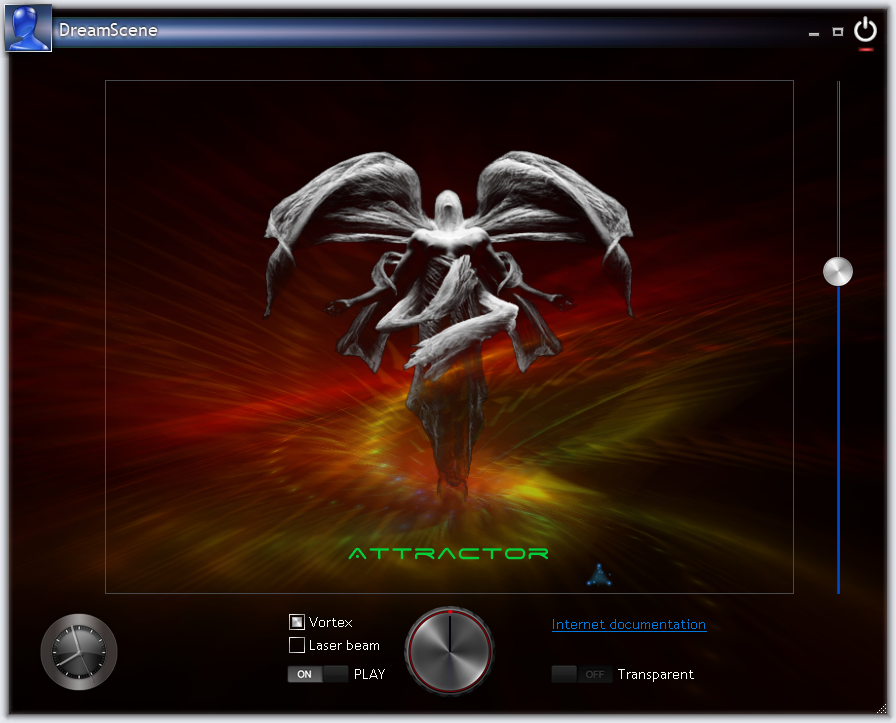This thread is to exposed a very special
GDImage/WinLIFT companion, named
ZWP (
Zapsolution
Window
Plugin).
Its purpose is to provide an easy way to display
OpenGL animations in the background, just like with the Vista Pro
DreamScene (2007), but for a specific application. The animation itself could run in full sync mode with a playing audio file, creating a peak level FFT signal in real time.
Here is a
DreamScene example, using the "
Vortex" plugin:

The above screen shot, has been taken from a
WinDev project, running in composited mode.
Compositing, means everything is rendered onto the Windows
DirectDraw surface, using multiple transparent layers.
This is made possible by using the unique combination of
GDImage and
WinLIFT, because they are
AERO compatible, since the introduction of
DWM in
Windows VISTA.
OpenGL animationsThey are able to use any
BassBox "Visual plugins", each one being a small
OpenGL DLL producing a specific visual effect. They are working under control of
ZWP, that is the link between the high level application and the low level plugins. It performs audio decoding, and sends messages to both the low level and the high level code.
The z-order of the
DreamScene is always kept behind the main window, that must be skinned by
WinLIFT to see it in variable opacity mode. The
GDImage graphic control, is able to share the same image background than the skin theme, or to run in opaque or full transparent mode.
How to use the demoThe GDImage graphic control, comprise:- A PNG animation, that could be zoomed and rotated, using the slider or the gauge button.
(click with the right mouse button, on either the slider or the gauge, to restore default).
- A label text, matching the name of the active audio file.
- A progress spinner animation moving from the left to the right while playing audio.
Each of the above sprite objects, are reacting to the audio peak level, while playing.
The WinLIFT button controls:- The "
Vortex" radio button, to select the matching plugin.
- The "
Laser beam" radio button, to select the matching plugin.
- The "
PLAY" switch, to turn audio "On" or "Off".
- The "
Transparent" switch, to turn the GDImage crystal mode "On" or "Off".
- The "
Internet documentation" link, that would display this page.
- The "
Clock" control.
About the supported audio format:-
Tracker:
mod, umx, mtm, it, xm, s3m, mo3.
-
Stream:
mp3, ogg, wav, aif.
There are several audio files, provided into the "Audio" subfolder.
To select a specific one, use
drag and drop from the Explorer onto the
DreamScene window,
and of course feel free to use your own songs if you prefer.
More about the visual plugins.They are written with OpenGL 2.00+, using specific set of textures (strored in the
BBplugin\Texture subfolder).
Each of the visual effect is a mix of artwork and advanced programming, some of them have taken weeks of work to produce the final result. This technology has been created for the
BassBox line of audio players. That means any
BassBox plugin could be used with the
DreamScene project.
What is it good for?The
DreamScene concept is great when you have to create presentation (or karaoke) on external display, with a mix of audio sensitive animations, overlayed text, and graphics.
What about the CPU being used?While
ZWP is very capable at decoding/playing audio files, it has a low memory impact, because the visual plugins are using the
GPU rather than
CPU. Most of the time (on an I7 computer) it uses between 2 and 3% of the whole CPU resource.
While Plugins are ideal for computer with low CPU resource, there is another {more demanding} companion named
ZWM (
Zapsolution
Window
Movie), that is able to play most video format using the
CCCP codecs. The result will look exactly the same, except that you have a movie playing in the background rather than OpenGL animations.
...